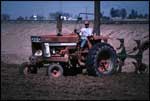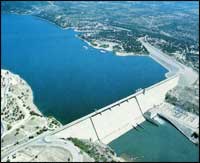The Hunter's Role
Destruction of the places where animals live—not hunting, as many people would have you believe—is today’s greatest threat to wildlife populations. In this country alone, it is estimated that the destruction is progressing at a rate of one million acres a year. Stop and think about it—one million acres of land each year that can no longer provide food, water, and shelter for the nation’s wildlife.
Another threat to wildlife (although neither group will admit it) is the continuing argument between hunters and anti-hunters over the question of hunting. While these two groups are busy arguing about their rights, wildlife is losing out. Acres and acres of wildlife land are being bulldozed away to make room for superhighways, high-rise buildings, shopping centers, housing developments, and new reservoirs. Strip mining, dredging, and other such activities also take their share of the land and waterways needed by wildlife.

Wouldn’t it be more sensible for hunters, landowners, and anti-hunters to join forces and work together to protect wild river areas, mountainsides, woodlands, wetlands, and wilderness areas for wildlife? If America’s wildlife heritage is to be preserved, wildlife will need all the friends it can get, whether they are birders, big game hunters, anglers, nature photographers, or some other type of outdoor enthusiast.
Just when the arguments between hunters and anti-hunters began, no one can really say. Perhaps the first ones took place in prehistoric times. Can you imagine cavemen arguing over whether it was right to kill woolly mammoths and saber-toothed tigers for food, especially when these animals began to become scarce? Although we don’t know when the first disagreements took place, arguments between the two groups became quite common at the turn of the century when the conservation movement really got underway in this country, and they are still going strong today.

Both groups seem to agree on the idea of protecting endangered species, but many dedicated conservationists and anti-hunting enthusiasts are unable to accept the fact that many forms of wildlife, such as deer, will overpopulate if their numbers are not controlled in some way. Some anti-hunters recommend that we “let nature take its course.” If man had never interfered with nature by cutting and flooding woodlands, draining the wetlands, plowing the prairies, and polluting the air and water, nature might have been able to keep in balance.
However, nature’s way of maintaining a balance can be very cruel. When animals become overpopulated and the land is unable to produce enough food for the animals, the surplus must die. It is only a question of how—nature’s way or the hunter’s way. When the food becomes scarce, browsers, such as deer, slowly die of starvation, in their weakened condition they are open to attacks from predators, parasites, and diseases. Some diseases can destroy as much as 90 percent of a deer herd within a few days. Nature takes its course and the herd is once again reduced to a level the land can feed. Was the starvation and disease of nature’s way, which killed young and old alike, more humane than the hunter’s bullet? Those who have seen a white-tailed deer in the last stages of starvation question whether nature’s way is best.

Agricultural needs, land-clearing projects, and man-made reservoirs hurt wildlife populations much more than hunting. Although reservoirs provide recreational opportunities for man, and in many instances serve as flood-control measures, they destroy the river bottomlands that once provided food and shelter for wildlife. When the surviving animals seek shelter in the lands surrounding the new reservoir, they may be displaced again as land developers move in to create a lakeside resort area complete with roads, homes, swimming pools, tennis courts, and golf courses.
Some anti-hunters realize that surplus animals must be removed, but they feel that the job of killing them should be handled by professional marksmen who would not get any “fun” or sport out of it. This idea has never really been accepted by the general public because the average person does not want to pay someone to do what hunters will do for free. They can see nothing wrong with the hunter harvesting the surplus for food and recreation.
Still another substitute
for hunting proposed by
anti-hunters is birth control
in wildlife. The federal
government actually tried
this method on the overpopulated
white-tailed deer in Mammoth
Cave National Park in Kentucky.
The experiment was successful
on penned deer when the
birth-control chemical was
added to their food, but
rangers found it impossible
to give daily doses to free-roaming
deer. Some of the wild deer
were trapped and given extra-large
doses of the chemical, but
eventually both the penned
deer and the free-roaming
deer refused to eat the
food containing the chemical.
Hormone injections were
also tried, but the researchers
were never able to learn
how long the hormones would
remain effective or what
effect they would have on
predators that might eat
the wild deer. During the
research nature stepped
in in the form of disease,
and the herd was reduced
once more to a manageable
population. After seven
years of experimentation,
the birth-control project
was abandoned.

Nature's way of removing surplus animals can be very cruel. When the land cannot produce enough food for the extra animals, many of them slowly starve to death. Once they become too weak to run, they are easy prey for predators. In their weakened or overcrowded conditions, they also are susceptible to diseases and parasites. Most birds do not live long in the wild. Severe weather conditions, disease, food shortages, and predators contribute to their high mortality rate. When hunters harvest game birds such as dove and quail for food, they are putting to use a natural resource that otherwise would be wasted. It is estimated that only 25 percent of the state's quail population survives from one year to the next whether hunting is allowed or not.
Why do people search so hard for a substitute for hunting? Sport hunting—properly regulated and based on scientific research—is recognized as the most efficient way to remove surplus wildlife, and it also serves as a form of recreation to those who enjoy hunting. All fifty state governments consider hunting a valuable management aid that not only things the overpopulated herds, but also puts this surplus to good use as food.
No American wildlife species has been exterminated by sport hunting since the development of modern wildlife management in the 1930s. In fact, wildlife management has increased many species. The nation’s white-tailed deer population, estimated at 350,000 animals in 1890, today numbers more than 15 million. This is more deer than were here when the Pilgrims landed. Since 1907, the elk population has grown from 41,000 animals to about a million, while the pronghorn antelope population has increased sevenfold and the wild turkey tenfold.
Since hunting does not endanger any wildlife species when the harvest is based on wildlife research and limited to surplus game, the question of whether to hunt or not is one that each person should be free to decide individually. However, each person also must learn to respect the opinions and rights of those who choose differently. Wildlife resources belong to all Americans, hunters and non-hunters alike, and instead of fighting with each other both groups should devote their energies to preserving lands for wildlife and share in the expenses of properly managing them for everyone’s enjoyment.
Ilo
Hiller
1983 The Hunter's Role.
Young
Naturalist. The
Louise Lindsey Merrick
Texas Environment Series,
No. 6, pp. 63-66. Texas
A&M University Press,
College Station.
Editor’s Note: This article was based on the National Wildlife Federation’s bulletin Should We Hunt?